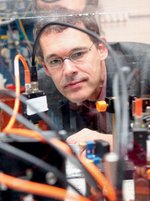
Nanosciences
The numerous cooperative endeavours amongst CENIDE’s researchers, around 170 of whom are financed from third-party funding, and collaborations with external partners once again resulted in a large number of publications, patents and successful projects in 2010 and 2011. The following report describes just a selection of topics from among the broad range of CENIDE research activities.
Nano and Information Technology
Magnetic nanoparticles smaller than 20 nanometres have applications in future intelligent sensors and in medicine, among others. In order for these sensors to function correctly, it must be possible to tailor their magnetic properties to a very high degree of accuracy. Professor Michael Farle’s research team has now quantitatively demonstrated for the first time that extremely small differences in the shape and composition of individual particles and the number of neighbouring particles have a dramatic impact on magnetic behaviour. In a related cooperative project led by Professors Peter Entel, Michael Farle and Heiko Wende, rules were established for producing nanomagnets with very precisely defined specifications. Their results make it possible to define the magnetic characteristics of a product prior to production. This research will therefore have an impact on the information technology (IT) sector – as does the work of Professor Axel Lorke’s research group. They were able to manipulate individual electrons in a semiconducting nanostructure in a controlled manner. Their results, which were achieved in cooperation with colleagues from the University of Hamburg and Ruhr University Bochum, represent an important step towards creating a new generation of computers which will have the ability to solve problems that current computers cannot.
Nano and Life
A question which has also garnered attention beyond the academic community was answered by Professor Matthias Epple’s team in the course of research undertaken within the DFG Priority Programme 1313 “Biological Responses to Nanoscale Particles”. Silver nanoparticles are increasingly being used in everyday objects for their antibacterial properties. The Epple group’s results have now shown why: as silver nanoparticles dissolve over time, they release silver ions, which in turn destroy microorganisms.
The influence of nanoparticles on higher organisms is the focus of “NANODEVICE”, an EU-funded research project in which Professor Heinz Fissan and Dr. Thomas Kuhlbusch are involved. Within this project, which will run until 2013, sensors are being developed which, simply attached to clothing, measure and quantify exposure to nanoparticles at the workplace.
Nanomaterials
The research team led by Professor Markus Winterer observed the growth of zinc oxide crystals (ZnO) at room temperature over an extended period of time. The researchers made use of a new model that describes the kinetics of crystal growth primarily in terms of the chemisorption of water. These results are relevant to all the various applications of zinc oxide nanoparticles, since it can be inferred that the long-term stability of the particles depends on the ambient water vapour pressure. By contrast, the stability of polymer chains studied by Dr. Nils Hartman’s group can be precisely controlled. His team showed that approximately 100-nanometre-long polymer chains can be used as tiny switches in future technological applications. The CENIDE researchers thus disproved the prevailing opinion that the structures’ reaction time would be too slow. The importance of this discovery is demonstrated by the respected journal Angewandte Chemie publishing the results as a “VIP Paper”.
Nano and Energy
The new “NanoEnergyTechnologyCenter,” or NETZ building, is currently under construction and will serve as a unique scientific research structure for linking fundamental investigations with applied research for industry. Within a chain of linked facilities, nanomaterials are studied and results transferred seamlessly to the applied research laboratories for further processing and functionalization for energy technology applications. The building will be completed in the autumn of 2012. Yet even without the new facility, cooperation between members of the NETZ project has been strong ever since its inception three years ago. One example is the cooperative research conducted by Dr. Gabi Schierning and Dr. Hartmut Wiggers. They became the first to synthesize efficient nanomaterials for thermoelectric applications from gas-phase reactions. This achievement marks a true breakthrough in the world of nanoresearch in light of the urgent need for new thermoelectric materials to replace tellurium, which is extremely expensive, or lead, which is a dangerous environmental pollutant. Nanosilicon presents a low-cost, nontoxic alternative. Using the Schierning and Wiggers method, it is possible to create pre-doped silicon-germanium alloys on a nanoscale in a single step.
Professor Michael Horn-von Hoegen’s research team investigates the growth of single atomic layers of crystalline carbon – the new wonder material graphene – on iridium substrates. His group has managed to synthesize defect-free graphene layers in one single process step. The collaborating research teams of Dr. Wolfgang Mertin and Professor Gerd Bacher have been studying functionalized graphene when it is connected to electrodes. Using an extremely precise measurement method, the researchers were able for the first time to determine the resistance of graphene at the contact point between the graphene and the electrode in high resolution and accurate to within one nanometre.
Professor Franz-Josef Tegude’s research team accomplished an exceptional feat in the field of photovoltaics research: semiconducting nanowires have a very small volume with a very large surface area. His team succeeded in creating extremely highly doped axial and coaxial galliumarsenide p-n junctions by selectively doping the shell and the core of the nanowires. With this technology, they were able to convert light into electricity extremely efficiently even under extreme conditions.
Many of the nanomaterials investigated, analyzed, functionalized or further processed by the CENIDE researchers originate from the Institute of Energy and Environmental Technology, e. V. (IUTA), an associated research institute of the University of Duisburg-Essen closely connected to CENIDE. Its pilot-scale synthesis facility can produce custom-designed nanoparticles from the gasphase in quantities measurable in kilogrammes per hour.
Nano and Education
CENIDE is not only concerned with current research issues, the Center also understands the importance of educating tomorrow’s scientists. This begins at an early age, with children being given the chance to visit physics laboratories and lecture halls as part of the “doors open day” organized by the famous German children’s television show “Sendung mit der Maus”. For high school students, CENIDE, in cooperation with the Department for Electrical Engineering and Information Technology and the UDE’s Faculty of Physics, runs the “zdi-Schülerlabor”, the only facility of its kind in Germany that is dedicated exclusively to projects in the field of nanotechnology. In one-day courses, or one-year projects that contribute towards students’ university entrance certificates, the teenage participants learn to conduct their own projects independently, using state-of-the-art research equipment. The next link in the educational chain at university level is the NanoEngineering degree course, with the “Young Researcher Network” (YRN) lastly bringing together CENIDE postdocs and supporting them in their scientific career. As one of the largest nanotechnology networks in Germany, CENIDE was involved in the “Perspektiven für die Nanotechnologie” (Perspectives for Nanotechnology) expert meeting organized by North Rhine-Westphalia’s Science Minister Svenja Schulze in 2011. As a consortium member of the “Nano/Micro+Materials Cluster”, CENIDE shares the goal of easing the way for nanoresearch and technology development today and in the future.


